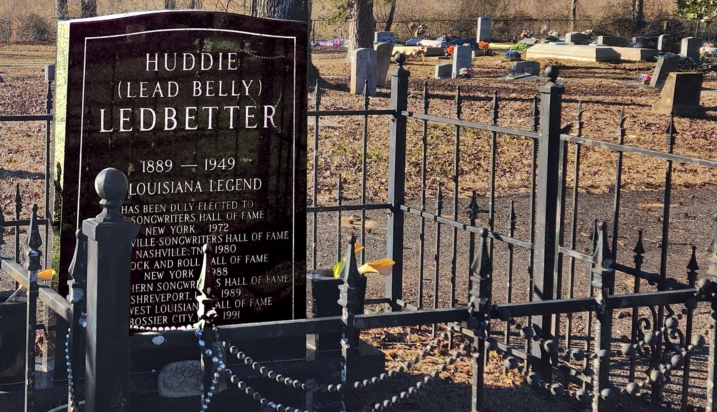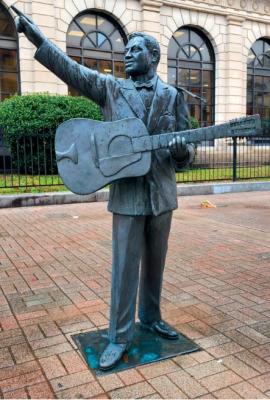
Author’s note: I chose to list the stops in this story chronologically, from Lead Belly’s birth to death.
However, if you desire to follow the stops in a more geographically sensible manner, they are as follows (starting in Shreveport): Stop #4, Stop #5, Stop #1, Stop #6, Stop #3, Stop #2 and then Stop #7.
Few artists have had as much influence on American music as Caddo Parish native Huddie “Lead Belly” Ledbetter. From Johnny Cash to the Beach Boys to Nirvana to Frank Sinatra to Eric Clapton, performers have recorded Lead Belly’s songs. With songs like “Goodnight Irene,” “Black Betty,” “Midnight Special,” “Where Did You Sleep Last Night” and “Cottonfields” to his credit, the music of Lead Belly transcends the entire pantheon of modern American music.
When Bob Dylan won the Nobel Prize for Literature in 2016, he attributed Lead Belly for his love of folk music, saying, “Somebody, somebody I’d never seen before, handed me a Lead Belly record with the song ‘Cottonfields’ on it. And that record changed my life right then and there – transported me into a world I’d never known.”
Lead Belly was an equally complex and violent character. He spent large chunks Cleveland, Ohio.
Even with all his incomparable musical accolades, no formal trail has been established to honor Lead Belly (yet) in Northwest Louisiana. The good news for Lead Belly fans is that retracing his early life steps is not hard to do. Lead Belly spent most of this time in the vicinity of the Caddo Lake region – so fill up the gas tank, grab some snacks and let’s hit the road!
Stop #1 Mooringsport, Louisiana
The unofficial Lead Belly trail starts near his birthplace – the Jeter Plantation outside Mooringsport. Although the plantation is long gone, its approximate location was a few miles south of town. Highway 169 (Greenwood-Mooringsport Road) passes near where Lead Belly was born. The exact date of his birth is often debated, although the Lead Belly Foundation cites his official birth as Jan. 20, 1889.
Stop #2 Leigh, Texas
When Lead Belly was only 5 years old, his family relocated to the small community of Leigh, just down the road in Harrison County, Texas. It was while living in Leigh that Lead Belly began performing regularly at sukey jumps and juke joints in the Caddo Lake region. Coming of age in Leigh, Lead Belly began to acquire his violent reputation, of time behind bars and was convicted of murder but eventually released. In time, his violent nature became as much a part of his story as his music. Despite his controversial and checkered past, Lead Belly is still highly regarded. In 1988, he was inducted into the Rock and Roll Hall of Fame in thanks partly to the “frontier” nature of the Caddo Lake region in the early 1900s. As a teenager, he was given a pistol that was used in several altercations. Today, Leigh only consists of a smattering of houses, a few businesses and one lone, dilapidated, twostory brick structure.
Stop #3 Marshall, Texas
Marshall, Texas, is the county seat of Harrison County. Because of Lead Belly’s time in Leigh and Harrison County and later Dallas, Texas, it often lays partial claim to the legacy of Lead Belly, and rightfully so. After befriending Blind Lemon Jefferson, Lead Belly would perform in the famed Deep Ellum neighborhood in Dallas. (If you are up for a short six-hour round trip out of the way, you can see a plaque honoring Lead Belly on the corner of Commerce and Walton streets in Dallas.) Closer to home, the Harrison County Historical Museum in Marshall has a small display mentioning Lead Belly and other East Texas musicians.
Stop #4: Fannin Street, Shreveport
In one recording of the song “Fannin Street,” Lead Belly recounts childhood trips from the Caddo Lake region to Shreveport to sell cotton. While in town, his father would show him around Fannin Street in the Saint Paul’s Bottoms neighborhood. At that time, the area was a red-light district notorious for saloons, brothels and dance halls located at the bottom of the hill below the First Methodist Church.
Recalled Lead Belly, “My papa would take me to Shreveport on some bales of cotton. He’d lead me all around on Fannin Street. You know, where the people dance and play and sing and pianos and women dancing. My father would lead me around by the hand in the daytime, and when he’d put the wagon in the wagon yard well at night, he’d put me in the wagon, yard, too, because I’d be asleep, and he’d be gone. When I’d wake up and he’d be gone, it would run around in my mind … he’s going right back down there where he carried me that day. I said, ‘Well, when I get to be a man, I’m going down there, too.’”
And return, he did. As a teenager, when Lead Belly made frequent trips to Shreveport to sell the family cotton, he ventured down to Fannin Street. There, he would get a front-row seat witnessing the various personalities and eclectic musicians who gravitated toward the red-light district. It’s not hard to imagine that Lead Belly felt right at home in the chaos, energy and lawlessness of Shreveport’s red-light district. The neighborhood was plagued with shootings and knife fights. In the book “The Life and Legend of Leadbelly” (1999), authors Charles Wolfe and Kip Lornell describe Saint Paul’s Bottoms as a “crucible of violence.” Lead Belly’s experiences on Fannin Street undoubtedly influenced his later musical style.
In 1982, Saint Paul’s Bottoms was renamed Ledbetter Heights in Lead Belly’s honor. Today, the brothels and dance halls are all gone, and Fannin Street at the “bottom of the hill” consists of a movie studio, vacant lots and new developments funded by the $24.2 million Choice Neighborhood Implementation Grant awarded to Shreveport in 2018.
Stop #5: Lead Belly Statue
Before leaving downtown Shreveport, make sure to snap a picture of the Lead Belly Statue located in front of the Shreveport Memorial Library Main Branch at 424 Texas St. The statue, pointing toward Ledbetter Heights, was erected in 1994 and designed by artist Jessie Pitts Jr.
Stop #6 Oil City, Louisiana
Oil City lies on the north side of Caddo Lake, not far from Mooringsport. Lead Belly was known to frequent the oil boomtown mainly because of familial connections. His uncle Bob Ledbetter lived there, among other family members. Uncle Bob was reputed to have taught Lead Belly the folk song “Goodnight Irene,” which Lead Belly later popularized.
Some accounts have Lead Belly also living briefly in Oil City. One story claims Lead Belly was stabbed in the neck while performing in the town. This lends credence to the theory that, later in life, Lead Belly wore the signature red bandana around his neck to hide a scar. Lead Belly’s connection to Oil City is honored with a historical marker at Earl G. Williamson Park on the north shore of Caddo Lake.
Stop #7 Lead Belly Gravesite, Shiloh Baptist Church
The final stop on the unofficial Lead Belly Trail is his gravesite at Shiloh Baptist Church near Mooringsport. The grave is only a few miles from where he was born on the Jeter Plantation. The well-appointed grave has become a mecca of sorts, with people traveling from across the world to pay homage to Lead Belly. Some do this simply by dropping a guitar pick on Lead Belly’s grave. Every year, fans of Lead Belly gather for a graveside musical jam in October.
Lead Belly died of ALS on Dec. 6, 1949. Amazingly, Lead Belly – the son of a sharecropper – performed his final show at Carnegie Hall in New York City.
No directional highway signage leads the way to Lead Belly’s grave (yet). Still, the quickest way to get there from I-20 is to take the Greenwood Exit #3 and drive north on Hwy. 169 (Greenwood-Mooringsport Road) for about 10 miles, then turn left onto Parish Road 6 (Blanchard Latex Road) and follow it for two miles. Shiloh Baptist Church and cemetery will be on your left.
For more information on the life and times of Lead Belly, visit www.leadbelly.org.